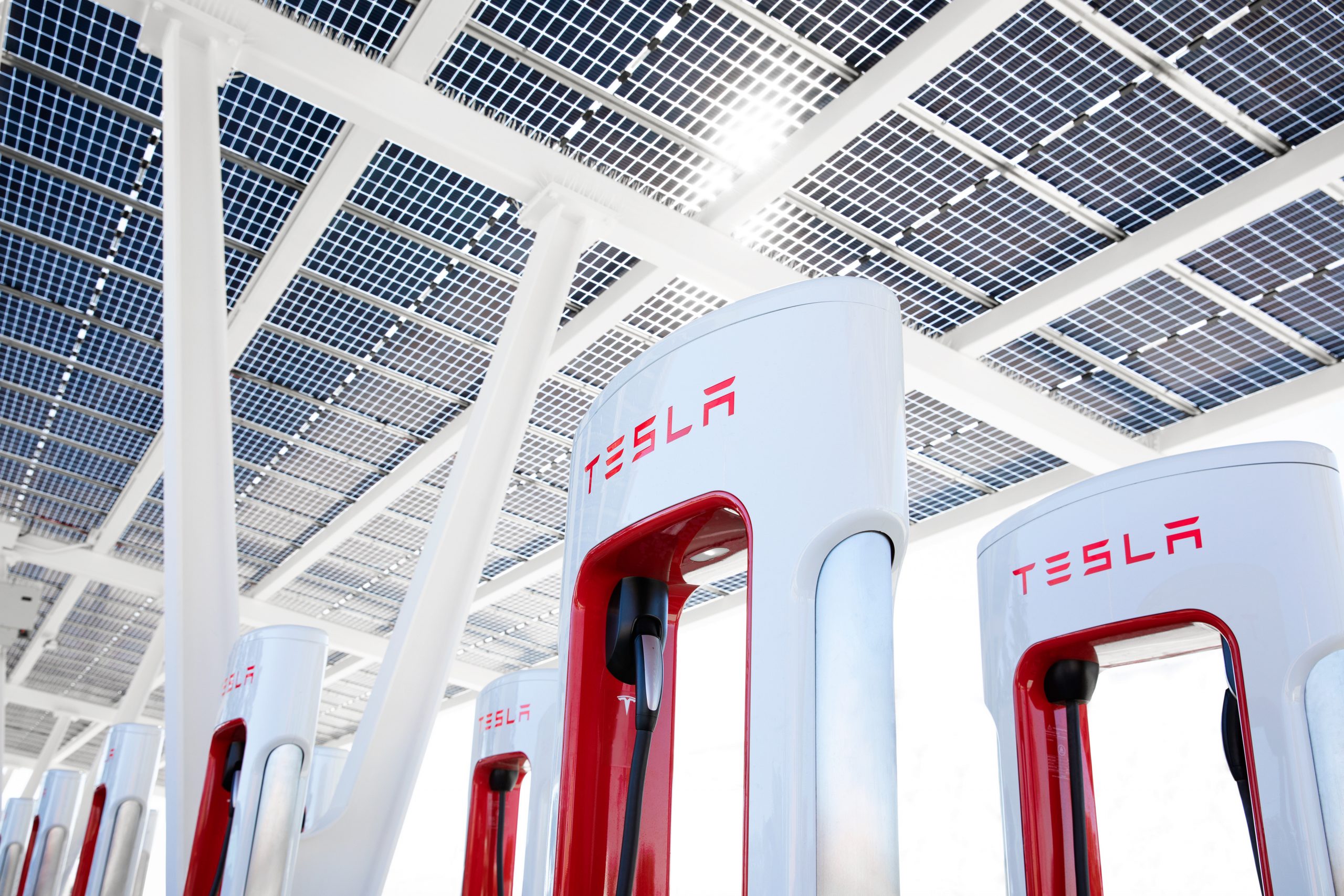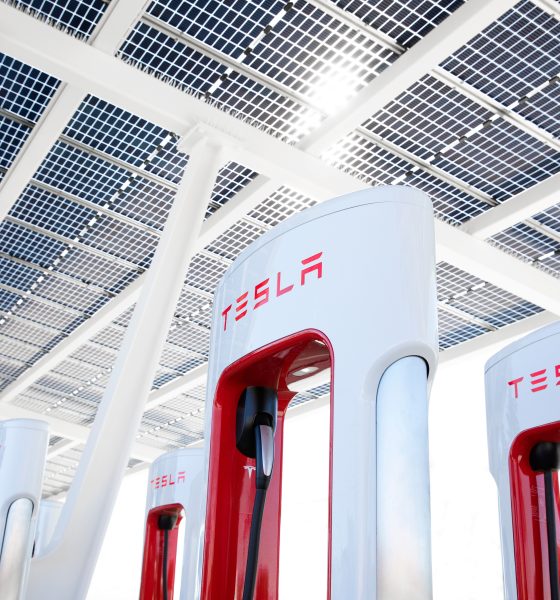

Investor's Corner
Tesla price target reductions, Rivian recall take focus as EV stocks slide
Electric vehicle stocks are continuing to slide on Monday as a broader market turnover continues to affect the economy. Tesla faced several price target reductions on Monday morning amidst a lower-than-expected delivery count for Q3, while Rivian shares are down due to a recall that affected over 12,000 vehicles. However, these are not the only two companies facing heat during Monday’s trading session.
Tesla
Tesla (NASDAQ: TSLA) shares have been beaten and battered over the past month, down over 27 percent. Last week alone accounted for a nearly 12 percent slip in Tesla share price, attributed to a weaker-than-anticipated delivery count when the company announced Q3 numbers earlier this month. Tesla delivered 343,890 vehicles but missed Wall Street expectations. The automaker detailed difficult supply chain conditions for the slide in deliveries, which ultimately ended up occurring in Q4 instead of Q3.
“As our production volumes continue to grow, it is becoming increasingly challenging to secure vehicle transportation capacity and at a reasonable cost during these peak logistics weeks,” Tesla said when it announced the delivery figures on October 2. “In Q3, we began transitioning to a more even regional mix of vehicle builds each week, which led to an increase in cars in transit at the end of the quarter. These cars have been ordered and will be delivered to customers upon arrival at their destination.”
These issues, while contributing to early Q4 deliveries, encouraged Morgan Stanley’s Adam Jonas to trim his Tesla price target from $383 to $350.
“We believe factors that drove Tesla’s weaker than expected 3Q production and deliveries could continue to present headwinds into 4Q as well as into FY23,” a note to investors said. Morgan Stanley trimmed its 2022 delivery outlook from 1.37 million vehicles to 1.31 million. The firm also revised its 2023 forecast by 200,000 cars from 2 million to 1.8 million.
“We reiterate our OW (overweight) rating on Tesla and continue to position the name as a core holding.”
Tesla also had its price target trimmed by UBS from $367 to $350, as analyst Patrick Hummel maintained a “Buy” rating. RBC Capital Markets analyst Joseph Spak also cut the firm’s price target on Tesla to $340 from $367.
Tesla shares were trading at $222.79 at the time of publish.
Rivian
Rivian (NASDAQ: RIVN) saw more than a 10.5 percent dip in Monday trading following a recall of more than 12,000 vehicles on Friday.
Rivian announced last week that it was issuing a recall on 12,212 R1T, R1S, and EDV (Electric Delivery Van) units due to a “loose steering knuckle fastener.” The NHTSA stated, “The fastener connecting the front upper control arm and steering knuckle may have been improperly tightened,” which may cause the fastener to separate and cause a loss of vehicle control.
“This is a black eye for Rivian now just starting to hit its stride on reaching its 25k production target,” Wedbush analyst Dan Ives said. “A modest setback.”
Rivian shares were trading at $30.63 at the time of publish.
Other EV Stocks: A rough day on Wall Street
Lucid (NASDAQ: LCID), Nio (NYSE: NIO), Li Auto (NASDAQ: LI), and Ford (NYSE: F) were all down at least 3 percent at 11:20 A.M. on the East Coast.
Ford’s 7.2 percent drop on Monday was the most notable. Wall Street continues skepticism on whether legacy automakers like Ford and GM can remain afloat among rising competition and a robust lineup of carmakers that show more promise in the EV sector. Analysts at UBS downgraded Ford and lowered its price target to $10 from $13. The Motley Fool stated in its synopsis of Ford’s struggles that the company’s key metrics for September were the weakest among U.S. automakers, making it more vulnerable during a recession than its peers.
Price increases on Ford’s F-150 Lightning have indicated the company is making the right moves to keep margins in the right place. Additionally, the company is feeling healthy demand from consumers as it recently suspended accepting orders on the Mustang Mach-E’s base trim, citing high demand and a long order backlog.
Ford stock was trading at $11.32 at the time of publish.
Disclosure: Joey Klender owns Tesla stock, but no shares of any other automaker mentioned in this article.
I’d love to hear from you! If you have any comments, concerns, or questions, please email me at joey@teslarati.com. You can also reach me on Twitter @KlenderJoey, or if you have news tips, you can email us at tips@teslarati.com.
Teslarati is now on TikTok. Follow us for interactive news & more.

Investor's Corner
Tesla stock closes at all-time high on heels of Robotaxi progress

Tesla stock (NASDAQ: TSLA) closed at an all-time high on Tuesday, jumping over 3 percent during the day and finishing at $489.88.
The price beats the previous record close, which was $479.86.
Shares have had a crazy year, dipping more than 40 percent from the start of the year. The stock then started to recover once again around late April, when its price started to climb back up from the low $200 level.
This week, Tesla started to climb toward its highest levels ever, as it was revealed on Sunday that the company was testing driverless Robotaxis in Austin. The spike in value pushed the company’s valuation to $1.63 trillion.
Tesla Robotaxi goes driverless as Musk confirms Safety Monitor removal testing
It is the seventh-most valuable company on the market currently, trailing Nvidia, Apple, Alphabet (Google), Microsoft, Amazon, and Meta.
Shares closed up $14.57 today, up over 3 percent.
The stock has gone through a lot this year, as previously mentioned. Shares tumbled in Q1 due to CEO Elon Musk’s involvement with the Department of Government Efficiency (DOGE), which pulled his attention away from his companies and left a major overhang on their valuations.
However, things started to rebound halfway through the year, and as the government started to phase out the $7,500 tax credit, demand spiked as consumers tried to take advantage of it.
Q3 deliveries were the highest in company history, and Tesla responded to the loss of the tax credit with the launch of the Model 3 and Model Y Standard.
Additionally, analysts have announced high expectations this week for the company on Wall Street as Robotaxi continues to be the focus. With autonomy within Tesla’s sights, things are moving in the direction of Robotaxi being a major catalyst for growth on the Street in the coming year.
Elon Musk
Tesla needs to come through on this one Robotaxi metric, analyst says
“We think the key focus from here will be how fast Tesla can scale driverless operations (including if Tesla’s approach to software/hardware allows it to scale significantly faster than competitors, as the company has argued), and on profitability.”

Tesla needs to come through on this one Robotaxi metric, Mark Delaney of Goldman Sachs says.
Tesla is in the process of rolling out its Robotaxi platform to areas outside of Austin and the California Bay Area. It has plans to launch in five additional cities, including Houston, Dallas, Miami, Las Vegas, and Phoenix.
However, the company’s expansion is not what the focus needs to be, according to Delaney. It’s the speed of deployment.
The analyst said:
“We think the key focus from here will be how fast Tesla can scale driverless operations (including if Tesla’s approach to software/hardware allows it to scale significantly faster than competitors, as the company has argued), and on profitability.”
Profitability will come as the Robotaxi fleet expands. Making that money will be dependent on when Tesla can initiate rides in more areas, giving more customers access to the program.
There are some additional things that the company needs to make happen ahead of the major Robotaxi expansion, one of those things is launching driverless rides in Austin, the first city in which it launched the program.
This week, Tesla started testing driverless Robotaxi rides in Austin, as two different Model Y units were spotted with no occupants, a huge step in the company’s plans for the ride-sharing platform.
Tesla Robotaxi goes driverless as Musk confirms Safety Monitor removal testing
CEO Elon Musk has been hoping to remove Safety Monitors from Robotaxis in Austin for several months, first mentioning the plan to have them out by the end of 2025 in September. He confirmed on Sunday that Tesla had officially removed vehicle occupants and started testing truly unsupervised rides.
Although Safety Monitors in Austin have been sitting in the passenger’s seat, they have still had the ability to override things in case of an emergency. After all, the ultimate goal was safety and avoiding any accidents or injuries.
Goldman Sachs reiterated its ‘Neutral’ rating and its $400 price target. Delaney said, “Tesla is making progress with its autonomous technology,” and recent developments make it evident that this is true.
Investor's Corner
Tesla gets bold Robotaxi prediction from Wall Street firm
Last week, Andrew Percoco took over Tesla analysis for Morgan Stanley from Adam Jonas, who covered the stock for years. Percoco seems to be less optimistic and bullish on Tesla shares, while still being fair and balanced in his analysis.

Tesla (NASDAQ: TSLA) received a bold Robotaxi prediction from Morgan Stanley, which anticipates a dramatic increase in the size of the company’s autonomous ride-hailing suite in the coming years.
Last week, Andrew Percoco took over Tesla analysis for Morgan Stanley from Adam Jonas, who covered the stock for years. Percoco seems to be less optimistic and bullish on Tesla shares, while still being fair and balanced in his analysis.
Percoco dug into the Robotaxi fleet and its expansion in the coming years in his latest note, released on Tuesday. The firm expects Tesla to increase the Robotaxi fleet size to 1,000 vehicles in 2026. However, that’s small-scale compared to what they expect from Tesla in a decade.
Tesla expands Robotaxi app access once again, this time on a global scale
By 2035, Morgan Stanley believes there will be one million Robotaxis on the road across multiple cities, a major jump and a considerable fleet size. We assume this means the fleet of vehicles Tesla will operate internally, and not including passenger-owned vehicles that could be added through software updates.
He also listed three specific catalysts that investors should pay attention to, as these will represent the company being on track to achieve its Robotaxi dreams:
- Opening Robotaxi to the public without a Safety Monitor. Timing is unclear, but it appears that Tesla is getting closer by the day.
- Improvement in safety metrics without the Safety Monitor. Tesla’s ability to improve its safety metrics as it scales miles driven without the Safety Monitor is imperative as it looks to scale in new states and cities in 2026.
- Cybercab start of production, targeted for April 2026. Tesla’s Cybercab is a purpose-built vehicle (no steering wheel or pedals, only two seats) that is expected to be produced through its state-of-the-art unboxed manufacturing process, offering further cost reductions and thus accelerating adoption over time.
Robotaxi stands to be one of Tesla’s most significant revenue contributors, especially as the company plans to continue expanding its ride-hailing service across the world in the coming years.
Its current deployment strategy is controlled and conservative to avoid any drastic and potentially program-ruining incidents.
So far, the program, which is active in Austin and the California Bay Area, has been widely successful.








